List of Mars orbiters
The following table is a list of Mars orbiters, consisting of space probes which were launched from Earth and are currently orbiting Mars. As of December 2016, there are up to fourteen known artificial satellites in Mars' orbit, six of which are active.[1]
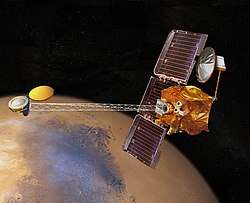
History
20th century

The Soviets' Mars program and the United States's Mariner program became the two first successful space programs that intended to explore Mars through orbiters. Mars 2, Mars 3 and Mariner 9 were all launched into space in May 1971, and all entered Mars’ orbit that same year. NASA's Mariner 9 reached the planet's orbit first on November 14, narrowly beating the Soviet's spacecraft amid the space race, and subsequently became the first spacecraft to orbit another planet.[2]
Contact with all eight Mars orbiters launched during the 20th century has been lost. NASA's four spacecraft are conjectured to remain in Mars' orbit. Mariner 9, Viking 1 and Viking 2 are expected to lower down into the Martian atmosphere by 2022 and either burn up or crash into the planet's surface.[3] Mars Global Surveyor is expected to crash onto the surface of the planet by 2047. The fate of the Soviet's three Mars program orbiters and Phobos 2 remains unclear, but they are still presumed to be in orbit.[4]
In 1999 the Mars Climate Orbiter impacted the Martian atmosphere.
21st century


2001 Mars Odyssey was launched April 7, 2001 on a Delta II rocket and currently holds the record for the longest-surviving continually active spacecraft in orbit around a planet other than Earth at 18 years, 9 months and 13 days.[5]
In 2003, the European Space Agency (ESA) launched their first planetary mission with Mars Express to conduct reconnaissance and exploration of Mars from orbit.[6] On 12 August 2005, NASA launched Mars Reconnaissance Orbiter (MRO). As MRO entered orbit in 2006, it joined three other active spacecraft which were in Mars' orbit: Mars Global Surveyor (MGS), Mars Express, and 2001 Mars Odyssey; at the time, this set a record for the most operational spacecraft in the immediate vicinity of Mars. MGS has since ceased to function.
On September 24, 2014, the Mars Orbiter Mission (Mangalyaan-1) was launched by the Indian Space Research Organisation(ISRO) and reached Mars orbit; ISRO became the first space agency to succeed in its first attempt at a Mars orbiter. ISRO launched the orbiter on November 5, 2013 as a "technology demonstrator" project. Its secondary goal is to analyze the Martian atmosphere and topography. The mission is the first successful Asian interplanetary mission.[7] Ten days after ISRO's launch, NASA launched their seventh Mars orbiter MAVEN to study the Martian atmosphere. Its goals include determining how the planet's atmosphere and water, presumed to have once been substantial, were lost over time.[8]
Fate
After achieving orbit, functional or not, Mars orbiters have been predicted to remain in orbit for a certain amount of time.[9]
- Viking 1 orbiter, likely to be in orbit until 2019[10]
- Mariner 9 is expected to remain in orbit until approximately 2022, when the spacecraft is projected to enter the Martian atmosphere and either burn up or crash into the planet's surface.[11]
- Mars Global Surveyor, around 2046 (1996+50 years)[12]
Besides decaying to Mars, a collision with a moon or other spacecraft is also a possibility.[13] In March 2017, MAVEN had to change its orbit to avoid colliding with Phobos, and with an increasing number of spacecraft at Mars this risk increases.[14] The Mars Global Surveyor is still being tracked, although it is no longer functioning.[15]
Table of objects
| Color legend | |
|---|---|
| Destroyed | |
| Loss of contact | |
| Operational | |
Note that days active category does not necessarily equate to time in orbit, for example Mars Global Surveyor is expected remain in Mars orbit for 50 years after its arrival.[16] The detection of derelict spacecraft in Mars orbit has some interest due to the minute risk of collision with such a spacecraft. One example of this is a proposal to use the Optical Navigation Camera on the Mars Reconnaissance Orbiter to search for small moons, dust rings, and old orbiters.[17]
| Artificial object | Agency | Launch date | Entered orbit | Days active | Image |
|---|---|---|---|---|---|
| Mars 2 | 19 May 1971 | 27 November 1971 | 269 days |  | |
| Mars 3 | 28 May 1971 | 2 December 1971 | 264 days |  | |
| Mariner 9 | 30 May 1971 | 14 November 1971 | 348 days | 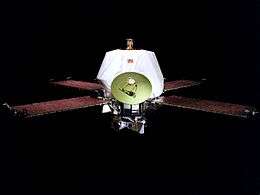 | |
| Mars 5 | 25 July 1973 | 12 February 1974 | 16 days |  | |
| Viking 1 | 20 August 1975 | 19 June 1976 | 1,520 days |  | |
| Viking 2 | 9 September 1975 | 7 August 1976 | 717 days |  | |
| Phobos 2 | 12 July 1988 | 29 January 1989 | 57 days | 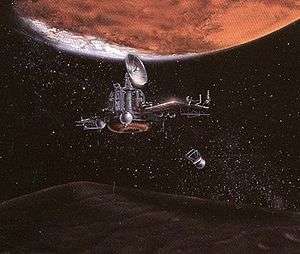 | |
| Mars Global Surveyor | 7 November 1996 | 12 September 1997 | 3,338 days | 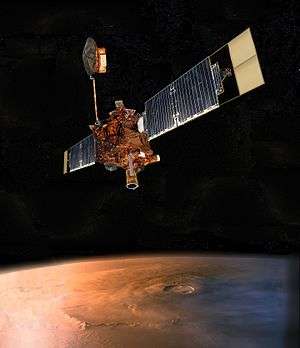 | |
| 2001 Mars Odyssey | 7 April 2001 | 24 October 2001 | 6,861 days |  | |
| Mars Express | 2 June 2003 | 25 December 2003 | 6,069 days | 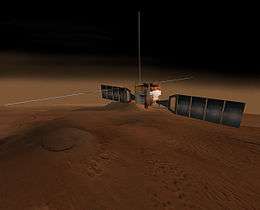 | |
| Mars Reconnaissance Orbiter | 12 August 2005 | 10 March 2006 | 5,263 days |  | |
| Mars Orbiter Mission (Mangalyaan) |
5 November 2013 | 24 September 2014 | 2,143 days | 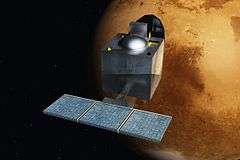 | |
| MAVEN | 18 November 2013 | 22 September 2014 | 2,145 days |  | |
| ExoMars Trace Gas Orbiter | 14 March 2016 | 19 October 2016 | 1,387 days | 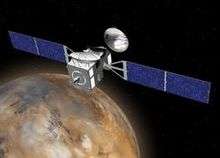 | |
See also
- Lists of spacecraft
- Exploration of Mars
- List of missions to Mars
- Robotic spacecraft
- Timeline of artificial satellites and space probes
- Timeline of planetary exploration
References
- "Mariner 9: Details". National Space Science Data Center. Retrieved December 28, 2011.
-
Pyle, Rod (2012). Destination Mars. Prometheus Books. pp. 73–78. ISBN 978-1-61614-589-7.
It was the first spacecraft to enter orbit around another world. ... [It] continues to orbit Mars to this day, sailing around the planet deaf and dumb in the cold darkness.
- NASA - This Month in NASA History: Mariner 9, November 29, 2011 — Vol. 4, Issue 9 Archived May 14, 2013, at the Wayback Machine
- Dunn, Marcia (October 27, 1996). "NASA Takes No Dirty Chances With Mars Rover". Los Angeles Times. Retrieved 2015-08-03.
It's expected to orbit Mars for at least 50 years before crashing onto the surface of the planet.
- "NASA's Odyssey Spacecraft Sets Exploration Record on Mars". Press Releases. JPL, NASA. 2010-12-15. Archived from the original on 2011-04-25.
- ESA - Mars Express - Mars Express Frequently Asked Questions (FAQs)
- "ISRO: Mars Orbiter Mission". isro.gov.in. Archived from the original on 2013-11-09.
- Brown, Dwayne; Neal-Jones, Nancy; Zubritsky, Elizabeth (September 21, 2014). "NASA's Newest Mars Mission Spacecraft Enters Orbit around Red Planet". NASA. Retrieved September 22, 2014.
- Dunn, Marcia (October 27, 1996). "NASA Takes No Dirty Chances With Mars Rover". Los Angeles Times. Retrieved 2015-08-03.
It's expected to orbit Mars for at least 50 years before crashing onto the surface of the planet.
- Jefferson, David C; Demcak, Stuart W; Esposito, Pasquale B; Kruizinga, Gerhard L (10–13 August 2009). An Investigation of the Orbital Status of Viking-1 (PDF). AIAA Guidance, Navigation, and Control Conference.
- NASA – This Month in NASA History: Mariner 9, November 29, 2011 – Vol. 4, Issue 9 Archived May 14, 2013, at the Wayback Machine
- Dunn, Marcia (October 27, 1996). "NASA Takes No Dirty Chances With Mars Rover". Los Angeles Times. Retrieved 2015-08-03.
It's expected to orbit Mars for at least 50 years before crashing onto the surface of the planet.
- "NASA spacecraft avoids potential collision with Martian moon - SpaceNews.com". SpaceNews.com. 2017-03-03. Retrieved 2017-12-31.
- "NASA spacecraft avoids potential collision with Martian moon - SpaceNews.com". SpaceNews.com. 2017-03-03. Retrieved 2017-12-31.
- "NASA spacecraft avoids potential collision with Martian moon - SpaceNews.com". SpaceNews.com. 2017-03-03. Retrieved 2017-12-31.
- Dunn, Marcia (October 27, 1996). "NASA Takes No Dirty Chances With Mars Rover". Los Angeles Times. Retrieved 2015-08-03.
It's expected to orbit Mars for at least 50 years before crashing onto the surface of the planet.
- M. Adler, et al. – Use of MRO Optical Navigation Camera .. (2012)
.jpg)
.jpg)